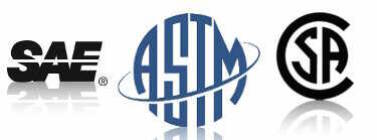What are the differences between hex bolts ordered as type 304 stainless steel, A193 Grade B8, and F593 Group 1 (type 304 stainless)?
Hex bolts are often ordered as a type 304 stainless and not to a specific ASTM specification. When bolts are ordered under the raw material grade (type 304) and not to an ASTM fastener specification, there are no specific requirements other than that they meet the chemical and physical requirements of 304 stainless steel and ASME B18.2.1 dimensional requirements for hex bolts. National coarse thread will typically be provided unless otherwise specified.
Type 304 stainless steel hex bolts that are ordered under the ASTM fastener specification A193 grade B8 are required to be both carbide solution annealed and stamped per the A193 specification. Carbide solution annealing is a process of heating the material up to a temperature of 1,950 degrees or above and maintaining the temperature long enough for the chromium carbides to go into the solution. This process will bring the bolts back to their optimal corrosion resistant condition after the forging (heading) process. The heads of bolts and one end of rods must be marked with “B8” and a unique manufacturer’s identifier. The A193 specification also requires 8 threads per inch above one inch diameter unless specified otherwise.
A type 304 stainless steel hex bolt that is ordered as ASTM F593 Group 1 must have additional processes performed that exceed the requirements of A193 grade B8. These bolts must be stamped with a manufacturer’s identifier, “F593″, and the proper condition designation, and if the bolts are hot formed, they must also be carbide solution annealed. Additionally, F593 bolts must pass an intergranular corrosion test, which is not required when bolts are ordered as type 304 stainless or under the ASTM A193 grade B8 specification. F593 does not have the same 8UN series thread requirement above 1″ diameter as A193 grade B8, and is typically provided with Unified National Coarse threads. The F593 specification is also characterized by a maximum diameter of 1-1/2”.
When headed stainless steel bolts are required, the hot forging process turns the heads of stainless steel bolts black and creates surface scale. This darkening of the stainless steel occurs when the round bar is heated to forge the bolt heads. Surface cleaning is optional and is performed through descaling (wheelabrating), pickling (acid treatment to remove heat-tinted surface steel layers), and passivating (restoring the chromium-rich complex, oxide film on the surface of the steel). Pickling and passivating is never a requirement when headed bolts are ordered under either ASTM specification (A193 grade B8 or ASTM F593), nor is it a requirement when simply ordering type 304 stainless steel headed bolts. Therefore, pickling and passivating is optional and should be specified by the purchaser at the time of inquiry and order. Pickling and passivating will increase the cost of the bolts and add to the lead time required to manufacture the product.




So if I ordered a generic “304 stainless bolt” from a fastener supplier, would I be getting A193/A320?
@Tom- Probably not. There are generic 304/18-8 bolts in the marketplace, and they are less expensive than their graded peers, so it would depend on your fastener supplier.
Is a bolt designated A593 Stainless steel the same as a bolt that is designated 18-8 Stainless steel?
@Tom- Yes and no. ASTM F593 is a general purpose standard that covers many grades of stainless fasteners. 18-8 steel can be used to manufacture F593 group 1 bolts, but there are mechanical and testing requirements. A bolt manufactured as “18-8” would not be able to be certified to F593 without testing and additional product marking. So you can call an F593 group 1 bolt 18-8, but not the other way around.
Is there a table that you can publish where the differences in chemical components between different types of stainless steel appear
18.8 A2 F593 304 316
@Luis- we have a break down in both F593 and A193 for each alloy. We see no need to compare chemistry across standards since they are identical.
Sir, what’s the difference between ASTM A193 Grade B8 / F593 Group 1 (type 304 stainless) and SUS304 in JIS G430? Thank you
@Alana- Our hunch is that SUS304 and type 304 stainless are the same thing chemically, but we are not familiar with JIS G430, so cannot be certain. Mechanically, stainless can vary depending on cold drawing, annealing, etc, so we cannot say how JIS G430 SUS304 compares strength-wise to F593 or A193.
We have a client who wants to use Gladys F593 THE, SS 304 finish 1/5 ” bolts with tinned plated Copper bus-bars. Considering the dissimilar metals and temperature coefficients of the different materials is this arrangement allowed?
The bolts were manufactured in Taiwan and state Gladys on the box AT30601
@Peter- the dissimilar metals issue is not a black and white one. Many factors can come into play when deciding if two metals can be used together. You will need to contact a metallurgist to determine if your application may create problems.
What would I either not spec an ASTM designnation, use 193 Grade B8, or spec F593 group 1? Which is preferred, or “better” to use?
@Brett- ASTM F593 is the general purpose standard, but it has not been fully adopted by the stainless fastening industry. Therefore A193 bolts are much more available in the marketplace. As to which is better or recommended, that is not something we can answer – it will depend on your application.
Is stainless steel more brittle than carbon steel (like 1554)? Any concerns about using SS anchor bolts for a tower leg in lieu of 1554, from a material standpoint?
@Martin- Most off the shelf stainless 304 or 316 bar is actually more ductile (less brittle) than F1554 gr.36,55 or 105. That said, stainless is not identical to any of the F1554 grades as far as tensile and yield, so care must be taken to make sure you are choosing a material that will work in all aspects of the application.
Does Solution annealing process includes carbide solution treatment and strainhardening?
@Hissan- Solution annealing and carbide solution treating are the same process, and strain hardening is an entirely separate process from both. Strain hardening must be performed after annealing, otherwise the annealing process will remove the strain hardening.
Dear Sir,
I have a question of making studs out of A479 bar 316. Is plain bar A479 316 purchased in solution annealed condition allowed to make studs or not. Kindly comment
Thanks and regards,
Savitha
@Savitha- Yes, normal A479 bar is available already solution annealed. You should be able to thread the material without having to re-solution anneal.
which is the best bolt can use in construction for heavy load ?thank you
@Eng Mir Dubai – You will need to contact an engineer for this question. We cannot make any specific recommendations.
Dear Sir,
I am manufacturing Anchor fasteners in mild steel, S.S.304, S.S.316,Duplex & super duplex with machined process. Now I wish to manufactured from 4 station header machine. to manufactured in mild steel it’s Ok, but for S.S.304 & 316 will it be possible in cold forming.
Please suggest us accordingly.
Best Regards
Deepak
@Deepak – I am sorry, but we do not have any information regarding cold forming. You may need to contact the manufacturer of the header you are using.
whether carbide solution treatment required for Grade 8 A194
@Karthick – No, carbide solution treating is not required for A194 gr.8 nuts.
sir, i have heat treatment shop. my customer send me ss304 bolt for carbide solution annealing class2 and strain hardening. he require hardness30/32 rc. i had done solution annealing at 1100 degree c.and observe hardness85/90 hrb. now how can i increase hardness? what temperature and time is suitable for strain hardening process? what is coolind method of strain hardening material? kindly help me other wise i will loose my customer. thank u sir.
@Jagdish Sharma – The strain hardening process is a cold drawing or cold forming procedure which occurs after heat treatment. Stain hardening is a mechanical process, not a heat treat process. We do not do any strain hardening in house, and so do not have any details on the specifics of the procedures. Apologies.
dOES IT HAVE ANY HARDNESS OR BHN
@JDR ENGG – Stainless grades per ASTM A276 (which only covers raw material) do not have any specified hardness values, although the producing mill will usually perform a hardness test for reference. Fasteners per ASTM F593 do have hardness requirements, ranging from HRB 65 for some annealed grades, to HRC 36 for some stain hardened grades.
what do we mean by carbide solution treated,strain harden fastners
@JDR ENGG – After hot forging, both ASTM A193 and F593 require fasteners to be carbide solution treated, which is a heat treat process that restores the corrosion resistant properties altered by hot forging. Strain hardening is a separate process that can increase the mechanical strengths of some grades of stainless steel by cold working the material, either through cold drawing, cold heading, or some other cold forming process.
I am a bike builder and use a lot of stainless metric fasteners usually socket (allen) head and button (allen) head for 90% of a given machine. However I am sometimes stuck using ugly grade8 hex head in places where I need the strength ie: kick stand, motor mounts etc….is there a stainless alloy that has “grade8” tensile strength or similar shear strength ?? I like a clean machine and but dont want it laying on its side with a sheared off sidestand bolt :0) …
Steffano Muzzatti